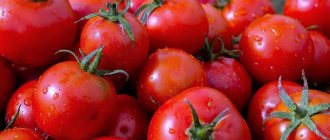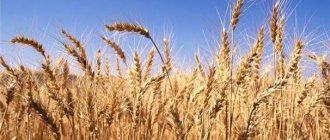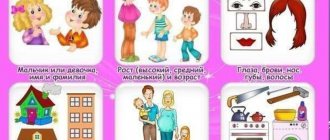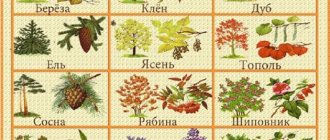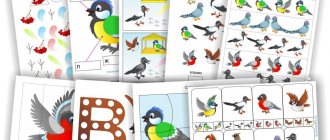Birds: wintering and migratory, wild and domestic
You can talk to your child that there are migratory birds that fly to warmer regions in the fall and return to us in the spring. And winterers who stay with us for the winter. They are wild and domestic. Often city children cannot understand the meaning of the word “homemade”; they do not live at home in the literal sense of the word. Or they can’t tell a goose from a duck or a duckling from a chicken. Look where the birds live, what kind of houses they have, they can be different.
Birds build their nests in different places, high in trees, in hollows, on steep river banks, under the roof of a house. You can make a birdhouse with your own hands and a cheerful, chirping family will live in it. Poultry lives in a poultry house, they sleep on a roost. Ducks and geese are waterfowl; they have webbed feet to make rowing convenient. Their feathers do not get wet in water. Riddle about a goose: “I swam in the water and remained dry.” Show your child the difference between a chicken and a rooster, and what colorful plumage it has.
Insects and small animals
As it gets warmer, more insects and other small animals appear. This is also a very fertile topic for enriching vocabulary and developing grammatical structure. Children, if they are not afraid, love to collect all kinds of small animals: worms, frogs, grasshoppers, beetles, snails. They make houses for them and put them in jars. Pay attention to the method of movement - some animals fly, others crawl, others jump and gallop.
Butterflies fly OVER the flower and land ON them, or maybe even on the palm. But it is better not to touch them, as they have very delicate wings. Bees fly and collect honey, and can also sting. Grasshoppers jump from grass to grass. And earthworms hide UNDER the boards. Snails can crawl on walls and leaves. The ladybug crawls along the palm, reaches the highest finger and flies away. While she is moving, you can say: “Ladybug, fly to the sky, your children are eating candy there.”
After the end of the summer season, we return home and remember how we spent the summer, what we did. And at this time, outside the window, autumn rain is pouring or a winter snowstorm is blowing. And we look at photographs, drawings and crafts, eat pickles and preserves, drink tea and make plans for next summer. To consolidate, you can play in a store (selling fruits and vegetables, tools), a barnyard and a zoo, an insect house.
This is where I finish writing this article, but there will be a continuation about outdoor games, trips to the forest, what to do in bad weather and on the beach near the water in good weather. And also how to organize a birthday party at the dacha. Follow the updates, subscribe to the news. Write in the comments about your impressions of outdoor recreation, the country house and the garden. Share with friends and relatives on social networks.
Signs of spring
The first big trip to nature usually happens during the May holidays. And here you can talk to your child about spring. List the signs of this time of year that distinguish it from others and at the same time have common characteristics:
- It's cool, it might snow like in winter, the trees are bare
- leaves and flowers begin to bloom, the grass begins to turn green, birds fly in and sing, insects fly like in summer
From this we can conclude that spring is like a transition period between winter and summer, an off-season. Winter constantly returns again and again, but its time has passed anyway. This is very important to clarify, because children with speech impairments often cannot answer the question: “What time of year is it now?”, they often confuse spring with winter (there is still snow and it’s cold), then with summer (it’s already warm and you can run without warm clothes), or even in the fall - by pronunciation (CH consonants) and by the changeability of the weather.
This is exactly what the development of thinking consists of: comparing, finding common and different things, learning to analyze and draw conclusions. At the same time, learn to observe how winter gradually turns into spring, and spring into summer. At the dacha and in the garden, this is easier to observe, since there is more free time and everything is in sight, right there we watch the sun as it rises higher and higher, rises earlier and sets later.
And the ground no longer becomes frozen in the morning, puddles are no longer covered with thin ice, and birds fly in from warm countries. And you can make a birdhouse and see how the inhabitants will live in it. Or maybe the swallows will build a nest under the roof. You can draw your child’s attention to how the birds fly and hover around their houses. Compare wild birds with domestic ones, which you can look at on the pond or with your neighbors, if your dacha is in the village. Or driving past a neighboring village.
Vegetables and fruits
And he can also take part in dacha work, depending on his age and inclinations: watering, weeding, replanting, hilling. And here comes the time for a favorite didactic topic: vegetables and fruits. In speech therapy classes, as well as in speech development in kindergarten, children learn to distinguish vegetables from fruits. Some grow in a garden bed, others on trees in the garden. Some are used to make borscht salad, others are used to make juice and jam. This lexical topic helps to practice a huge number of grammatical categories.
- characteristics of the object: color, size, taste, shape, smell, tactile sensations (the cucumber is oval, green, pimply, hard, and the tomato is round, red, smooth and soft)
- prepositions: on (trees, beds, bushes), in (ground, vegetable garden, garden), near, between, next to
- diminutive forms (cucumber, turnip, onion, carrot) and plural in the nominative and genitive case (cucumber - cucumbers - a lot of cucumbers)
- words - actions in different forms: dig - digs - dig, dug - dug - will dig
Tools
It will also be interesting for your child to learn about tools. Explain that there are working tools (saw, hammer, axe) and gardening tools (shovel, rake), what they are used for, and what they do with them. If you are making a birdhouse (bench, gate), you need to saw off the boards and drive in nails. We dig the beds with a shovel, level them with a rake, and remove debris from the site. You can buy children's instruments for children so that they can use them to the best of their ability to do something, to take part in a common cause.
Water from a watering can, collect garbage, hammer nails into a board next to dad. It would be appropriate to talk about compliance with safety precautions. And then let the kid tell you what you need to do so as not to hit your finger with a hammer and how to position the rake correctly so that it doesn’t hit anyone with its handle. Why you can’t walk on dug-up beds, and how to hold a watering can correctly so that water doesn’t spill in vain.
Wild and domestic animals, as well as their young
This provides an excellent opportunity to look at the animals up close and almost touch them. This is a good time to learn the names of baby animals. Children often call a piglet a pig and a foal a horse. And especially for those who have speech problems, it is difficult to remember who is whose mother, father, son. It is possible to practice lexical material using a visual example, for example: “cat - cat - kitten - kittens” or “bull - cow - calf - calves”.
Learn to use correctly: “one pig - two pigs - five pigs.” And also the lamb is from a sheep, and its father is a ram. The hen has the chick, and the father is the rooster. It would be nice to photograph all these domestic animals, and then, looking at the photographs, remember. Look for them in pictures, coloring books, choosing the right colors (the chicken is yellow and the goose is white). At the same time, vocabulary is consolidated, grammatical structure, sensory and fine motor skills are developed.
Development of lexico-grammatical structure
Let's touch on several lexical topics that can be practiced in this situation:
- signs of spring
- tools: gardening, working
- migratory, wintering and domestic birds
- plants
- vegetables fruits
- wild and domestic animals
- insects and other small animals
The dictionary is activated, translated from passive to active.
At the same time, it is necessary to practice the correct use in constructing sentences and phrases:
- case endings of nouns
- agreement with adjectives in gender, number and case
- signs of an object
- subject actions
- the position of objects in space relative to each other (to the left, above, far)
And the ability to build a dialogue, conduct a conversation:
- remember what happened
- tell me what you are doing now
- tell us what you are going to do in the future
correctly arguing and justifying your actions.
Plants
In addition to animals, we pay attention to plants. Firstly, based on their size, the trees are large and tall, the shrubs (bushes) are shorter, and the grass and flowers are very short and thin. But at the same time, they also have common characteristics: leaves, stems, roots and flowers. You can compare deciduous and coniferous trees (evergreens) - “Winter and summer are the same color. What is this?". “In the spring it turns green, but in the fall it turns yellow?”, remember riddles about trees and plants
Then you can move on to comparing cultivated and wild (wild and domestic) plants. Here we remember garden flowers (tulips, daffodils) and wildflowers (daisies, buttercups), compare trees that grow in the forest and in the garden (fruit trees). Please note that the apple tree can be wild, wild and that its fruits are small and sour. Wild plants grow on their own, but cultivated plants need to be looked after. And here you can not only tell the child, but also show him what to do in the garden.
